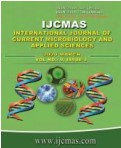


 National Academy of Agricultural Sciences (NAAS)
National Academy of Agricultural Sciences (NAAS)

|
PRINT ISSN : 2319-7692
Online ISSN : 2319-7706 Issues : 12 per year Publisher : Excellent Publishers Email : editorijcmas@gmail.com / submit@ijcmas.com Editor-in-chief: Dr.M.Prakash Index Copernicus ICV 2018: 95.39 NAAS RATING 2020: 5.38 |
The experiment was conducted at Bihar Agricultural University, Sabour. This experiment consisting of nine treatments under rice establishment techniques viz., - Zero tillage (T1), Permanent bed (T2)and Conventional Tillage (T3) and Sub-plot Rice based systems rice-wheat (S1) rice- maize (S2) and rice- lentil (S3).The paper focuses on conservation agriculture (CA), defined as minimum soil disturbance (NT) and permanent soil cover combined with rotations, as a more sustainable cultivation system for the future. The paper then describes the benefits of CA, a suggested improvement on CT, where NT, mulch and rotations significantly improve soil micronutrient properties. All these fractions was recorded the highest in T1S3 and marginal recorded in other treatment like T2S3, T3S3 and lowest recorded in T3S2and T3S2. Zinc fraction tend to be present in higher levels under zero tillage with residue retentions compared to conventional tillage. The distribution of total Zn into residual fraction was also reported to be more than 90 per cent. It was also recorded the highest zinc fraction in zero tillage (T1) compared the permanent bed and lowest zinc fraction observed in conventional tillage in postharvest soil. Effect of different cropping system rice-wheat, rice-maize and rice- lentil on zinc fraction was recorded highest value in rice lentil cropping system and lowest recorded in rice-maize cropping system. The data on correlation coefficient values among different zinc fractions of soil revealed that dynamic equilibrium of zinc existed as positive and highly significant correlation co-efficient values were noted among these fractions.
 |
 |
 |
 |
 |